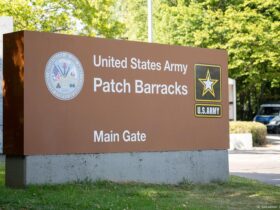Eleven months after a tough ceasefire agreement between Israel and the Iran-backed Hezbollah militia in Lebanon, violent clashes are once again escalating. On Thursday, Israel attacked an alleged Hezbollah training camp in Lebanon’s northwestern Beqaa region., A day earlier, an Israeli drone killed Hezbollah commander Isa Ahmed Karbala in the south of Lebanon, according to a statement from the Israel Defense Forces, or IDF.
Karbala is the latest in a series of deaths since a US and France-brokered ceasefire was signed between Israel and Hezbollah on November 27, 2024. It was intended to end nearly a year of limited fighting and two months of full-scale war, during which Israel said it significantly reduced Hezbollah’s weapons arsenal and killed several of the militia’s leaders.
Recently, Lebanese health officials said that 274 people have been killed in Israeli attacks since the ceasefire took effect. In October, the United Nations forward Confirmed 108 of them were civilians or non-combatants.
A recent report by the multinational United Nations Interim Force Lebanon (UNIFIL) also reported that about 950 projectiles were fired from Israel into Lebanon between November last year and mid-October 2025, in addition to 100 Israeli airstrikes.
During the same period, UNIFIL reported 21 projectiles fired from Lebanon toward Israel.
breach the agreement
Both Israel and Hezbollah have accused the other side of not meeting key aspects of the ceasefire. The agreement stipulated that Israel would withdraw its troops from Lebanese territory, while Hezbollah would disarm all of Lebanon and deploy its forces about 40 kilometers (25 mi) north of Lebanon’s Litani River. Meanwhile, the Lebanese army will deploy troops alongside UN peacekeepers in southern Lebanon.
Israel has accused Hezbollah, whose military wing is designated a terrorist group by several countries including the US and EU, of trying to rebuild its capabilities rather than giving up its weapons.
UN human rights experts blamed israel Accused it of violating the terms of the ceasefire by failing to withdraw from southern Lebanon, and called on all parties to return to the agreement, which was designed to ensure a “permanent cessation of hostilities”, as then-United States President Joe Biden said at the time.
Last week, Tom Barrack, a Middle East diplomat and US special envoy for Syria, posted on Twitter that “Disarming Hezbollah … is not only Israel’s security imperative; it is an opportunity for renewal.”
deadlock dilemma
Meanwhile, Lebanon is struggling after several years of political vacuum as well as an ongoing economic crisis, which was exacerbated by the war that lasted from September to November 2024. According to Lebanon’s Ministry of Public Health, Israel’s attacks killed about 4,000 people, destroying parts of Beirut and several villages in Lebanon’s south. world bank assessment of That reconstruction would cost approximately $11 billion (€9.5 billion).
However, most of the foreign aid promised by the US and Saudi Arabia is tied to economic reforms and the disarmament of Hezbollah.
Only, plans to disarm Hezbollah by the end of 2025 have reached a standstill, Kelly Pettillo, a Middle East researcher at the European Council on Foreign Relations (ECFR), told DW.
Hezbollah argues that they will not surrender their weapons as long as Israel continues attacking villages and construction factories vital to reconstruction. Earlier in August, Hezbollah had also warned of civil war in Lebanon.
Meanwhile, Israel has deployed its troops to five locations in the south of Lebanon, citing the need for self-defense.
“This situation poses a significant threat to Lebanon’s stability, as the Lebanese government under President Joseph Aoun is unable to exert any significant leverage to change the course of these actors,” ECFR’s Petillo told DW.
In his view, this impasse has prompted Israel to intensify its military attacks. “This could be a sign that Israel feels like it could slide back into full-scale conflict at any time if it believes that Hezbollah will not disarm,” he said, warning that such a scenario – in which Israel could attack targets in other countries to deter threats – could easily become a blueprint for other conflicts in the region.
Mona Yacoubian, director of the Middle East program at the Center for Strategic and International Studies think tank, told news agency AP. Interview Earlier this week she saw the scenario in Lebanon as one of “low fire” rather than a ceasefire.
He warned that Lebanon “could serve as a model for Gaza, essentially giving Israeli forces free rein to attack whenever they feel threatened without a full resumption of conflict.”
Return to resolution 1701
Beirut-based political analyst Ronny Chatah highlights several differences between Lebanon and Gaza. While Israel vowed to eliminate Hamas after its attack on Israel on October 7, 2023, the threat does not extend to Hezbollah.
Chatah views the US-brokered peace plan between Israel and Hamas as separate from the ceasefire between Israel and Hezbollah from October 10, 2025: “What happened at the end of 2024 is enhancing the enforcement mechanisms of Security Council Resolution 1701,” Chatah said.
In 2006, a month-long war between Hezbollah and Israel – called the Second Lebanon War after the First Lebanon War between 1982 and 1985 – ended with the approval of UN Resolution 1701.
The resolution mandated the deployment of Lebanese troops and UN peacekeepers to southern Lebanon, the withdrawal of Israeli forces from the same area as well as the disarmament of Hezbollah.
However, Hezbollah neither retreated further north beyond Lebanon’s Litani River, nor did the militias abandon their weapons. In the years since, with Iran’s support, Hezbollah’s military equipment and number of trained fighters has increased manifold.
Following the Hamas-led attack on Israel on October 7, 2023, tensions escalated when Hezbollah began targeting Israel for supporting Gaza. About 60,000 Israelis had to evacuate the area, as well as about 110,000 Lebanese on the northern side of the border.
‘Hard to feel safe’
Given Iran’s disinterest in encouraging the complete disarmament of what was once their most important asset outside their borders, and American support of Israeli military actions, Chatah believes there are only limited prospects that the Lebanese government could soon achieve an arms monopoly and complete control over its entire territory.
Instead, they fear that targeted killings, missile attacks on Hezbollah infrastructure, more civilian deaths and the constant hum of drones could become Lebanon’s status quo for some time.
“To be honest, it’s hard to feel safe or comfortable, with Israeli drones constantly flying low and making loud, disturbing noises,” Maryam Fanish, 25, told DW in Beirut. He said he was concerned and worried that the situation would escalate into war again.
Similarly, Raghid Awadeh, 23, is not hopeful the ceasefire will last. “Hezbollah does not care about population or humanitarian losses, and it obstructs any agreement that includes arms transfers to the Lebanese state,” he told DW.
Edited by: M. Sass






Leave a Reply